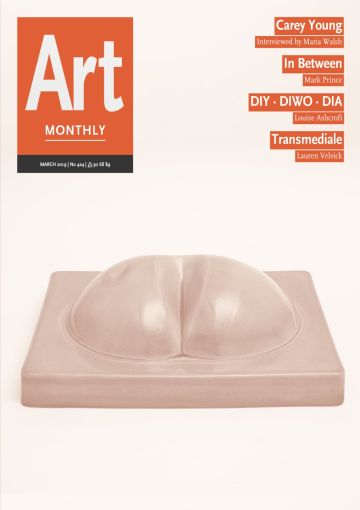Review
Jared Pappas-Kelley: Solvent Form – Art and Destruction
Michael Hampton explores Jared Pappas-Kelley’s idea that art is revealed through its destruction

Jared Pappas-Kelley: Solvent Form – Art and Destruction book cover detail
Solvent Form is an important new addition to a constellation of recent texts that have addressed destruction and art – Michael Lent’s Courting Dissolution, 2017, Henri Lefebvre’s The Missing Pieces, 2016 (Reviews AM391), Sylvère Lotringer and Paul Virilio’s The Accident of Art, 2005, and exhibitions such as the Hirshhorn Museum’s ‘Damage Control’, 2013-14, Tate’s award-winning virtual show the ‘Gallery of Lost Art’, 2012-13, and ‘Under Destruction’, 2011, at the Swiss Institute, New York – but while acknowledging their content, this book does far more than summarise their narratives, since Jared Pappas-Kelley’s study develops its own radical take on the subject. Signalling from the outset that Solvent Form will be ‘an undoing process’, the average reader will scarcely be prepared for his in-depth, fastidiously researched examination, quotational density (248 endnotes by page 45), and bombshell of a conclusion.
Pappas-Kelley enlists destruction – through fire, theft, disappearance or design – as a critical reagent showing up previously hard-to-discern, internal or ‘solvent’ characteristics of all artworks. The main historical touchstones in this complex disquisition are Jean Tinguely’s Homage to New York, 1960, Rachel Whiteread’s House, 1993-94, the 2004 Saatchi collection Momart fire (particularly Tracey Emin’s appliqué tent Everyone I Have Ever Slept With 1963–1995, 1995), the series of brazen continental art thefts perpetrated by the cafe waiter Stéphane Breitwieser, and Urs Fischer’s melting wax sculpture Untitled, 2011.
Directing his gaze to the ‘Gallery of Lost Art’, a remarkable inventory of loss curated by Jennifer Mundy (trailed by Jonathan Jones’s ‘Lost Art Project’ articles in the Guardian), Pappas-Kelley analyses this elegiac virtual warehouse with its ‘ever present audio-track attending the chalk and tape outlines of the deceased objects depicted’, much as a detective might a criminal case, doggedly trying to find out what it means when an artwork is destroyed, labelling its solvency a ‘permeable moment’, its poise or formal resolution (ie the market-driven end product) only masking the irresistible entropic processes coded into every artwork’s inception. Ultimately, it is postulated, ‘the thing’ seeks to escape itself – get shipwrecked on purpose, according to Virilio – with accidents such as Alexander Calder’s stabile Bent Propeller, 1970, lost in 9/11 (an event described by the Art Loss Register as ‘probably the largest single art loss in history’) acquiring even greater valency as memento mori. Also placed under the microscope in Solvent Form is Tinguely’s Homage, which – not unlike Banksy’s recent stunt at Sotheby’s auction house (Artlaw AM421) – didn’t quite go right on the night. The wayward contingency of this kinetic scrapyard masterpiece and its one-off Götterdämmerung-like self-disintegration (eventually dowsed and left a smoking wreck by the local fire department) is legendary. Today, Health and Safety regulations would simply rule out John Latham’s guerrilla Skoob towers or Tinguely’s public excesses. From here the argument of Solvent Form advances in hops via Thomas Demand’s Landing, 2006, an exemplary reconstruction of a conservator’s photograph of three smashed Qing vases at the Fitzwilliam Museum in Cambridge, Gustav Metzger’s Manifesto Auto-Destructive Art, 1960 – with its pedagogic disdain for romantic ruins – and Agnes Martin’s austere drawing practice (were her rectangular grids a swipe at Kazimir Malevich’s macho square?) to Jim Lambie’s vertiginous floor piece made from coloured vinyl tape, Zobop, 1999, and Fischer’s weeping effigy, attempting to graph art’s perpetual oscillation between the primal urge to shatter and to mend, with the related issue just below the surface, not only of if but also how to represent/curate the physical presence of the missing object. This became all too real for Pappas-Kelley, speaking of the Momart fire in an interview with Dennis Cooper: ‘There isn’t a single image of it in my book as the rights were too high. Like the storage spaces, it’s about access.’
In Pappas-Kelley’s grungy universe ‘art’ is a portmanteau word (he works overtime to finally kill off the notional red herring that art or the thing has an essence), and solvency a slippery concept which also ‘means further layoffs, selling off cultural artefacts, privatisation, austerity’. But the most intense philosophical grappling is with the foreclosed object, one liable to be lost to the manifold hazards of theft, fire, vandalism etc (their dark energy rupturing the history of western aesthetics), the ineffable artwork reconceived as a betrayed process. Haunted by loss throughout, perhaps the most poignant viewpoint in Solvent Form is dockworker Sid Gale’s bewilderment at the ‘lovely woodwork and mouldings the other way round’ in his former front room at 193 Grove Road in east London, obliterated by the poured concrete cast of Whiteread’s House, a site of double destruction after the latter’s municipal demolition.
Jared Pappas-Kelley, Solvent Form: Art and Destruction, 2018, Manchester University Press, 160pp, hb, £80, 978 1 526129 24 6.
Michael Hampton is a writer based in London and author of Unshelfmarked: Reconceiving the artists’ book.
First published in Art Monthly 424: March 2019.











